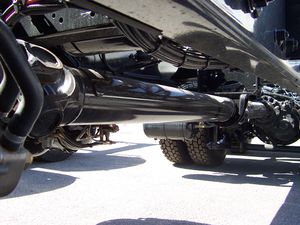Drive shaft

The drive shaft (also called propeller shaft or prop shaft) is a component of the drive train in a vehicle, with the purpose of delivering torque from the transmission to the differential, which then transmits this torque to the wheels in order to move the vehicle.[2] The drive shaft is primarily used to transfer torque between components that are separated by a distance, since different components must be in different locations in the vehicle. A front-engine rear-wheel drive car must have a long drive shaft connecting the rear axle to the transmission since these parts are on opposite sides of the car.
Drive shafts are used differently in different vehicles, varying greatly in cars with distinct configurations for front-wheel drive, four-wheel drive, and the previously mentioned front-engine rear-wheel drive. Other vehicles also use drive shafts, like motorcycles, locomotives, and marine vessels. Below is the drive shaft configuration for a common front-engine rear-wheel drive vehicle (some cars have the transmission at the back).

For Further Reading
For further information please see the related pages below:
- Fuel efficiency
- Torque
- Drive train (there's a fun video explaining differentials there)
- Transmission (vehicle)
- Or explore a random page
References
- ↑ Wikimedia Commons [Online], Available: http://en.wikipedia.org/wiki/Drive_shaft#/media/File:Universal_joints_shaft.jpg
- ↑ Wise Geek, What is a Drive Shaft? [Online], Available: http://www.wisegeek.com/what-is-a-drive-shaft.htm
- ↑ Made internally by a member of the Energy Education team.

